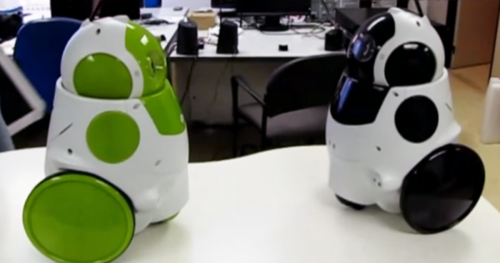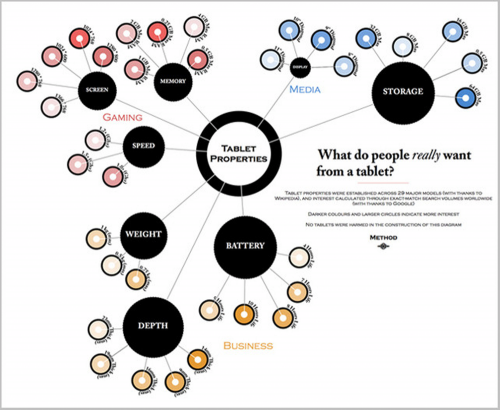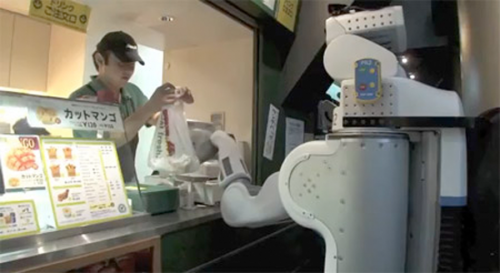Mobile devices empower shoppers.
Half of smartphone and tablet owners compare prices, 44% seek coupons and 17% have purchased at least one product via their mobile devices. via mediapost [RK]
Half of smartphone and tablet owners compare prices, 44% seek coupons and 17% have purchased at least one product via their mobile devices. via mediapost [RK]
Tap-To-Pay Smartphones: will become commonplace after Apple introduces the next iPhone. via forbes [RK]
 click > enlarge
click > enlarge
Mobile is the most pervasive technology ever invented. More People Have Mobile Phones Than Electricity Or Drinking Water. via silicon alley insider

To start, taking into account this particular instance of Qbo’s “consciousness” is done programmatically rather than arising naturally out of a deeper awareness of self should not diminish Qbo’s achievement. Qbo not only can recognize itself but also distinguish itself from other identical machines and carry on a simple conversation using speech synthesis (Festival) and recognition (Julius) programs. Qbo’s developers have simulated self-awareness through mimicking the way humans recognize themselves: we learn what we look like and verify by checking to see if our actions are mirrored. The nose flashes are the messaging system. The green robot can figure out if the the flashes coming from the black robot are his flashes and that the black robot looks enough alike to be one of his “species” which triggers the funny seduction line. Stay tuned.
Research and development by TheCorpora. [ qbo robot blog ]
 the bigger a black circle is, the more that subject was searched for. the darker the color in nodes branching off, the more intense the search activity was. >click to enlarge
the bigger a black circle is, the more that subject was searched for. the darker the color in nodes branching off, the more intense the search activity was. >click to enlarge
Tablet computers by now are sufficiently evolved with a diverse and experienced user-base to glean what people expect, like and want from them. Here’s an infographic generated via Google on what people are interested in and searching for.
The infographic suggests people don’t seem to care much about speed, screen size, or memory. Precisely the tech specs marketeers pitch with most gadgets today. That said, the memory vs storage can be construed as the same thing to non-techies: people may want the option for more “memory” to capture movies and music that require processing power hence why the battery is important. Regarding screen size, the tablet size offerings do not vary more than two-three inches. But size is indeed a factor for those who use both a smart phone and a tablet, we much prefer the tablet. A tablet offers a larger visual presentation but people what something compact too.
I’m surprised that price isn’t in here. Looking at non-iPad offerings there’s a big drop-off in price for a vast majority of the tablets. Interestingly, we don’t see lines in front of retailers offering the cheaper tablets.
If Steve Jobs were still here this might not be said this way at this time: he’s hugely responsible for getting a whole lot of people to pony up. We’re reminded in an article that an Apple smart TV could have been in the works and may in fact be coming. The article makes note that Apple and Jobs have a record of taking existing technologies and redesigning them with an emphasis on visual simplicity, enabling users to play songs, open applications and make calls with the click of a mouse or the swipe of a finger — with little technical knowledge required.
Along with price I wonder why age isn’t factored in as a great many older users have jumped many generations of desktop computers to enjoy the simplicity of playing with and using the tablets. Maybe we also need an infographic showing who’s interested and buying the tablet computer.
The infographic reminds us that a survey, a focus group, is the wrong process to generate a great idea by just asking people. Jobs said, “It’s not the consumer’s job to know what they want.” Finally, it does not go unnoticed, we couldn’t get this infographic without the wonder of Google.
The tablet research was conducted by design and branding agency, Method, and commissioned by Dell. Read the following links for other opinions. [ co. design ] [ visualizing.org ] [ chicago tribune ]

The University of Tokyo and Technische Universität München, uses semantic search to task a PR2 robot with fetching a sandwich. The PR2 has no detailed information on sandwiches, but its database tells it that sandwiches are a type of food, and that food can be found in kitchens and restaurants, its database also has maps and locations, and from that, it figures out where to look. The robot has to figure out how to find and use an elevator to a lower level where a Subway is located.
“Semantic search” is the process of deriving logical conclusions from premises known or assumed to be true. In this example it’s a computerized version of what we humans think of as “common sense.” For example, if someone asks you to bring them a glass without telling you exactly where the glass is, you’re probably smart enough to infer that a glass can be found in cabinets or dishwashers, and cabinets and dishwashers are typically located in a kitchen, so you can go to the kitchen, poke around a bit, and find a glass.
[ willow garage ]
apple keeps iphone at 4. less wow but aiming at fast-growing markets via chicago tribune [RK]

laurie rosenwald (designer) reveals how not working is better than working, and how to sell it [click photos to enlarge]
Author of this post (designer) cuts and pastes this and that, drafts a definition of design: (noun) refers to 1. a plan or convention, for the construction of an object or a system, manifested by an agent(s), intended to accomplish goals, in a particular environment, using a set of primitive components-or not, satisfying a set of requirements, subject to constraints; 2. no generally-accepted definition of “design” exists, and the term has different connotations in different fields.
With that definition in hand contemplate the purpose of the Cusp Conference—the design of everything. Greg Samata, Dave Mason, Kevin Kreuger (designers) of Smbolic (formerly SamataMason) and Joan Julian (glue) in four years have created a tightly run, cutting-edge, sometimes quirky, always inspiring, sold out, two-day creativity summit/boot camp.

matt diffee (cartoonist) always is asked where he gets ideas…he thinks of them. he points out the design of the images – and words if there are any.

sarah elizabeth impel is (founder/ceo/educator) of a chicago public elementary school connecting organic gardening, children, and education. one of many speakers making lemonade out of lemons.
 van phillips (inventor) athlete and amputee is motivated to create flex-foot cheetah (oscar pistorius) shares refinements such as a limb designed for water skiing
van phillips (inventor) athlete and amputee is motivated to create flex-foot cheetah (oscar pistorius) shares refinements such as a limb designed for water skiing

yves behar (planet-hot designer) points out how to subtract materials from herman miller’s ergonomic & sustainable sayl chair. this award winner inspired by suspension bridges
Happy I attended again, sad I did not win the give-a-ways, again, like quite a few Herman Miller Sayl Chairs or Scott Wilson’s TikTok or LunaTik iPod Nano wrist docks among other things. A conference that displays design in many shapes, colors, and sounds. Follow DesignApplause and others via #Cusp @CuspConference | facebook.com/CuspConference | quote: the creative adult is the child that has survived @RitaJKing [ cusp ] [ herman miller ] [ lunatik ] [ designchat ]
10 Reasons LED Light Bulbs will soon replace the Swirly bulb (CFL) via go green america tv [RK]
Line2 HD is a new app turns your iPad into a phone.
It’s an easy-to-use addition that puts phone calls, texts, voicemail and e-mail on a single screen—and offers a stack of other features as well.
Like Line2’s iPhone app the HD version lets you make or receive calls over a 3G or Wi-Fi connection. You get a new phone number (like Google Voice), which can also receive texts and has voicemail.
A feature of the voicemail is that it can send an audio file to your email so you can listen over your computer, in case if you don’t have your iPad with you. You can also forward calls to another phone, such as your land line. Line2’s app also connects to your iPad contact list and features call waiting, caller ID, and conference calling for up to 20 people.
Calls can be made using the iPad’s built-in microphone, so you can use it as a speakerphone for conference-room calls, or you can use a wired mic. If you have an iPad 2, you can also connect with a Bluetooth headset.
Test calls over Wi-Fi sounded as good as a typical mobile phone call.
The app is free, however, to use the app you need to purchase an account, which is $10 a month or $100 a year, paid up front. But wait, you can make calls over Wi-Fi, you can make unlimited calls from overseas without paying international calling fees. If you use something like Skype when traveling, you’ll have to check if you spend more than $100 a year on it, in which case Line2 would be a comparative bargain. A premium service at $15 a month or $150 a year add features like call screening and caller-specific forwarding, among others.
All content ©2007 > 2024 DesignApplause